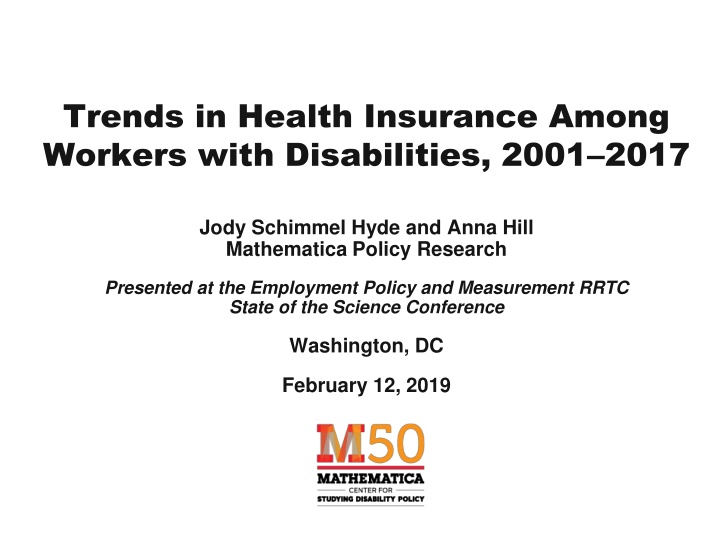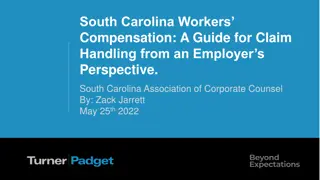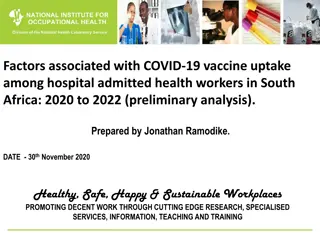Trends in Health Insurance Among Workers with Disabilities, 2001-2017 Analysis
Study conducted on health insurance trends for workers with disabilities from 2001 to 2017 reveals significant changes, with limited options in the past evolving into improved coverage post the Affordable Care Act (ACA). The shift includes removal of pre-existing conditions limits, Medicaid expansions, health insurance marketplaces, and extended dependent care benefits. The study identifies challenges faced by workers with disabilities in obtaining coverage and highlights the impact of ACA on de-linking health insurance from employment, thus changing incentives.
Download Presentation

Please find below an Image/Link to download the presentation.
The content on the website is provided AS IS for your information and personal use only. It may not be sold, licensed, or shared on other websites without obtaining consent from the author.If you encounter any issues during the download, it is possible that the publisher has removed the file from their server.
You are allowed to download the files provided on this website for personal or commercial use, subject to the condition that they are used lawfully. All files are the property of their respective owners.
The content on the website is provided AS IS for your information and personal use only. It may not be sold, licensed, or shared on other websites without obtaining consent from the author.
E N D
Presentation Transcript
Trends in Health Insurance Among Workers with Disabilities, 2001 2017 Jody Schimmel Hyde and Anna Hill Mathematica Policy Research Presented at the Employment Policy and Measurement RRTC State of the Science Conference Washington, DC February 12, 2019
In the Past, Limited Health Insurance Options for Adults with Disabilities Public health insurance conferred with federal disability receipt Medicare with SSDI, Medicaid with SSI Other public coverage (VA/Tricare) Employer-sponsored health insurance coverage Only for those working in covered occupations Nongroup coverage Costly, limits on pre-existing conditions
The Changed Landscape Patient Protection and Affordable Care Act (ACA) 2010 2010: Removal of pre-existing conditions limits and lifetime benefit caps, extended dependent care until age 26 2014: Medicaid expansions to individuals with incomes up to 138% of poverty level, health insurance marketplaces for group coverage, premium subsidies
Why Consider Workers with Disabilities? Workers with disabilities may: Earn too much to be eligible for federal disability benefits Work in part-time, non-salaried jobs or in positions/industries without coverage De-linking of health insurance and employment in ACA may be particularly salient and change incentives
Questions We Answer How did the share of working adults with disabilities who had health insurance change from 2001 2017? How did the source of coverage among insured workers with disabilities change over the same period? How did these changes compare to changes in other groups? Adults with disabilities who are not working Workers without disabilities
Identifying Workers with Disabilities National Health Insurance Survey (NHIS), 2001 2017 Employed: Worked for pay in the past 1 2 weeks Disability: Affirmative response to having a health condition that limits quantity/type of work About 1,400 workers with disabilities each year
Classifying Health Insurance Health insurance at the time the survey was conducted Any Medicaid: Medicaid in combination with any other source Medicare (but no Medicaid) Purchased through employer only Other: private purchase, other public, combinations not categorized above Uninsured if none of the coverage sources
Rates of Uninsurance Dropped Among Workers with Disabilities 25 22.5 20.8 20.5 Percent without health insurance 20 18.6 19.720.120.8 20.7 19.520.0 16.9 18.8 16.9 15 15.8 12.2 13.3 10 11.4 5 0 2001 2002 2003 2004 2005 2006 2007 2008 2009 2010 2011 2012 2013 2014 2015 2016 2017 Source: Authors calculations using the IPUMS Health Surveys, 2001 2017.
Increases in Coverage Similar Across Disability and Employment Status Groups 95 90 85 Percent insured 80 75 70 Working, disability 65 60 2001 2002 2003 2004 2005 2006 2007 2008 2009 2010 2011 2012 2013 2014 2015 2016 2017 Source: Authors calculations using the IPUMS Health Surveys, 2001 2017.
Increases in Coverage Similar Across Disability and Employment Status Groups 95 90 85 Percent insured 80 75 70 Working, disability 65 Not working, disability 60 2001 2002 2003 2004 2005 2006 2007 2008 2009 2010 2011 2012 2013 2014 2015 2016 2017 Source: Authors calculations using the IPUMS Health Surveys, 2001 2017.
Increases in Coverage Similar Across Disability and Employment Status Groups 95 90 85 Percent insured 80 75 70 Working, disability Not working, disability 65 Working, no disability 60 2001 2002 2003 2004 2005 2006 2007 2008 2009 2010 2011 2012 2013 2014 2015 2016 2017 Source: Authors calculations using the IPUMS Health Surveys, 2001 2017.
Increases in Coverage Similar Across Disability and Employment Status Groups 95 90 85 Percent insured 80 75 70 Working, disability Not working, disability 65 Working, no disability Not working, no disability 60 2001 2002 2003 2004 2005 2006 2007 2008 2009 2010 2011 2012 2013 2014 2015 2016 2017 Source: Authors calculations using the IPUMS Health Surveys, 2001 2017.
Types of Coverage Contributing to Increased Share with Insurance 100 90 Share of workers with disabilities (%) Sources of coverage for workers with disabilities 80 70 60 Uninsured 50 Medicare (no Medicaid) 40 30 Employer-sponsored only 20 Private purchase/other 21.2 10 Any Medicaid 11.1 8.7 0 Source: Authors calculations using the IPUMS Health Surveys, 2001 2017.
Types of Coverage Contributing to Increased Share with Insurance 100 90 Share of workers with disabilities (%) Sources of coverage for workers with disabilities 80 70 60 Uninsured 50 Medicare (no Medicaid) 40 30 16.3 Employer-sponsored only 20 Private purchase/other 13.0 13.3 21.2 10 Any Medicaid 11.1 8.7 0 Source: Authors calculations using the IPUMS Health Surveys, 2001 2017.
Types of Coverage Contributing to Increased Share with Insurance 100 90 Share of workers with disabilities (%) Sources of coverage for workers with disabilities 80 70 60 44.2 Uninsured 50 50.6 52.3 Medicare (no Medicaid) 40 30 16.3 Employer-sponsored only 20 Private purchase/other 13.0 13.3 21.2 10 Any Medicaid 11.1 8.7 0 Source: Authors calculations using the IPUMS Health Surveys, 2001 2017.
Types of Coverage Contributing to Increased Share with Insurance 100 90 Share of workers with disabilities (%) 6.0 Sources of coverage for workers with disabilities 80 5.6 4.6 70 60 44.2 Uninsured 50 50.6 52.3 Medicare (no Medicaid) 40 30 16.3 Employer-sponsored only 20 Private purchase/other 13.0 13.3 21.2 10 Any Medicaid 11.1 8.7 0 Source: Authors calculations using the IPUMS Health Surveys, 2001 2017.
Types of Coverage Contributing to Overall Increase 100 12.2 20.1 90 20.8 Share of workers with disabilities (%) 6.0 Sources of coverage for workers with disabilities 80 5.6 4.6 70 60 44.2 Uninsured 50 50.6 52.3 Medicare (no Medicaid) 40 30 16.3 Employer-sponsored only 20 Private purchase/other 13.0 13.3 21.2 10 Any Medicaid 11.1 8.7 0 Source: Authors calculations using the IPUMS Health Surveys, 2001 2017.
Compositional Changes in Coverage Source Among the Insured Workers with disabilities Workers without disabilities Nonworkers with disabilities 100% 13.8 17.4 90% 23.0 80% 13.5 13.3 52.1 12.0 70% 64.5 69.6 78.2 60% 25.3 83.7 87.1 26.4 25.6 50% 40% 18.7 30% 15.6 6.5 47.5 14.0 42.9 20% 39.4 6.2 13.8 5.4 22.7 11.7 10% 9.7 13.7 11.0 7.7 4.3 2010- 2013 3.0 2001- 2009 0% 2001- 2009 2010- 2013 2014- 2017 2014- 2017 2001- 2009 2010- 2013 2014- 2017 Any Medicaid Medicare (no Medicaid) Private purchase/ other Employer-sponsored only Source: Authors calculations using the IPUMS Health Surveys, 2001 2017.
Compositional Changes in Coverage Source Among the Insured Workers with disabilities Workers without disabilities Nonworkers with disabilities 100% 13.8 17.4 90% 23.0 80% 13.5 13.3 52.1 12.0 70% 64.5 69.6 78.2 60% 25.3 83.7 87.1 26.4 25.6 50% 40% 18.7 30% 15.6 6.5 47.5 14.0 42.9 20% 39.4 6.2 13.8 5.4 22.7 11.7 10% 9.7 13.7 11.0 7.7 4.3 2010- 2013 3.0 2001- 2009 0% 2001- 2009 2010- 2013 2014- 2017 2014- 2017 2001- 2009 2010- 2013 2014- 2017 Any Medicaid Medicare (no Medicaid) Private purchase/ other Employer-sponsored only Source: Authors calculations using the IPUMS Health Surveys, 2001 2017.
Compositional Changes in Coverage Source Among the Insured Workers with disabilities Workers without disabilities Nonworkers with disabilities 100% 13.8 17.4 90% 23.0 80% 13.5 13.3 52.1 12.0 70% 64.5 69.6 78.2 60% 25.3 83.7 87.1 26.4 25.6 50% 40% 18.7 30% 15.6 6.5 47.5 14.0 42.9 20% 39.4 6.2 13.8 5.4 22.7 11.7 10% 9.7 13.7 11.0 7.7 4.3 2010- 2013 3.0 2001- 2009 0% 2001- 2009 2010- 2013 2014- 2017 2014- 2017 2001- 2009 2010- 2013 2014- 2017 Any Medicaid Medicare (no Medicaid) Private purchase/ other Employer-sponsored only Source: Authors calculations using the IPUMS Health Surveys, 2001 2017.
Compositional Changes in Coverage Source Among the Insured Workers with disabilities Workers without disabilities Nonworkers with disabilities 100% 13.8 17.4 90% 23.0 80% 13.5 13.3 52.1 12.0 70% 64.5 69.6 78.2 60% 25.3 83.7 87.1 26.4 25.6 50% 40% 18.7 30% 15.6 6.5 47.5 14.0 42.9 20% 39.4 6.2 13.8 5.4 22.7 11.7 10% 9.7 13.7 11.0 7.7 4.3 2010- 2013 3.0 2001- 2009 0% 2001- 2009 2010- 2013 2014- 2017 2014- 2017 2001- 2009 2010- 2013 2014- 2017 Any Medicaid Medicare (no Medicaid) Private purchase/ other Employer-sponsored only Source: Authors calculations using the IPUMS Health Surveys, 2001 2017.
Compositional Changes in Coverage Source Among the Insured Workers with disabilities Workers without disabilities Nonworkers with disabilities 100% 13.8 17.4 90% 23.0 80% 13.5 13.3 52.1 12.0 70% 64.5 69.6 78.2 60% 25.3 83.7 87.1 26.4 25.6 50% 40% 18.7 30% 15.6 6.5 47.5 14.0 42.9 20% 39.4 6.2 13.8 5.4 22.7 11.7 10% 9.7 13.7 11.0 7.7 4.3 3.0 2001- 2009 0% 2001- 2009 2010- 2013 2014- 2017 2010- 2013 2014- 2017 2001- 2009 2010- 2013 2014- 2017 Any Medicaid Medicare (no Medicaid) Private purchase/ other Employer-sponsored only Source: Authors calculations using the IPUMS Health Surveys, 2001 2017.
Summary of Findings Workers with disabilities experienced: Decline in uninsurance after 2014 that was similar to the decline seen in other groups Notable increases in coverage from Medicaid and privately purchased sources Decline in employer-sponsored health insurance that seems to be larger than it is for other groups Important: we cannot measure individual substitution across sources of coverage
Implications of Increase in Medicaid Coverage among Workers with Disabilities Alternative to seeking federal disability benefits for health coverage Potentially reduces disincentive to work Reduction in full-time job lock We observe an increase in part-time status among employed workers over study period Potentially better array of covered services in Medicaid relative to employer plan (Gettens and Henry 2015)
Acknowledgements Funding for this study was provided by the Research and Training Center on Employment Policy and Measurement at the University of New Hampshire, which is funded by the National Institute for Disability, Independent Living, and Rehabilitation Research in the Administration for Community Living, U.S. Department of Health and Human Services, under cooperative agreement 9ORT5037-02-00.
Contact Information Jody Schimmel Hyde Center for Studying Disability Policy Mathematica Policy Research (202)554-7550 jschimmel@mathematica-mpr.com http://www.DisabilityPolicyResearch.org























